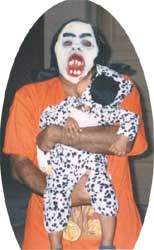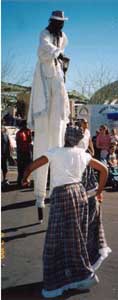
Dimdima
Online Children's Magazine from India

Dimdima
Online Children's Magazine from India

Hello friends! This fortnight, how would you like to dress up in your favourite fancy dress costumes, and join me in celebrating the American festival of Halloween? Celebrated on the 31st of October, Halloween kicks off the official "Holiday Season" in the United States. We can trace the roots of modern day Halloween traditions back to different cultures from around the world.
The ancient Celts (people living in Ireland), celebrated "Samhain," (pronounced "sow-en") on November 1st. It marked the end of summer and the beginning of autumn. On October 31st, after the farmers harvested the last of the crops, the villagers would extinguish all the cooking fires. The Celts believed that evil spirits roamed the earth on the night of October 31st, looking for human bodies to possess. They would, therefore, dress up in ghoulish costumes, sing loudly and parade through the village after sunset to scare away the evil spirits. The next morning, the Druids (priests) would bring down embers lit from a special sacred fire. They would pass the embers on to the villagers and the people would celebrate the Celtic New Year by lighting fresh fires in their kitchens. These fires would keep them warm from the cold winter winds during the next few months. 
When the Romans invaded Great Britain, they brought with them their own culture and traditions. They celebrated November 1st as Pomona Day. Pomona was the Roman goddess of fruit and trees. She was symbolized by an apple. Later, somewhere around the year 835 AD, the Catholic Church declared November 1st as "Hallowmas," or "All Saints Day." Groups of Christians would roam the villages on November 2nd begging for square pieces of bread known as "Soul Cakes." In return for the cakes, the beggars would promise to pray for the souls of the donors' dead relatives.
Halloween, as we celebrate it in the United States today, is a curious mixture of all these old rituals. The festival itself became popular when the Irish people began migrating to the US in large numbers during the 1840's to escape the "Potato Famine," that was ravaging their country. In the beginning, Halloween was often used as an excuse by unruly teenagers to wreak havoc in their neighborhoods. They would play practical pranks on their unsuspecting neighbors. Eventually, however, community groups took matters into their own hands and gradually this became a family festival where all members of the community come together to have harmless fun.
Now kids dress up as their favorite cartoon characters and go "trick-or-treating," on the night of October 31st. Like the ancient Christian beggars, the kids knock on their neighbours' doors and ask for candies, chocolates and other treats. If the neighbours do not have candies to treat the kids with, they're forced to entertain them with a trick. Many communities host special Halloween parties where even grownups come dressed in fantastic costumes. Bobbing for apples is a favorite Halloween party game that seems to be a relic of the Roman festival of Pomona Day.
People decorate the front of their houses with pumpkins and other Fall vegetables. Sometimes, the pumpkins have eyes, nose and a mouth carved into them. The insides of these pumpkins are hollowed out and candles are placed within. These scary pumpkin faces are called "Jack-O-Lanterns." People also place huge cutouts of scary looking monsters, witches and skeletons on their porches and play scary music through speakers to scare away the trick-or-treaters. In neighbouring Mexico, Halloween is celebrated as Dia de los Muertos (Day of the Dead). Families honour their dead relatives on this day.
Dimdima is the Sanskrit word for ‘drumbeat’. In olden days, victory in battle was heralded by the beat of drums or any important news to be conveyed to the people used to be accompanied with drumbeats.
Bharatiya Vidya Bhavan
K. M Munshi Marg,
Chowpatty, Mumbai - 400 007
email : editor@dimdima.com
Bharatiya Vidya Bhavan
505, Sane Guruji Marg,
Tardeo, Mumbai - 400 034
email : promo@dimdima.com
Dimdima.com, the Children's Website of Bharatiya Vidya Bhavan launched in 2000 and came out with a Printed version of Dimdima Magazine in 2004. At present the Printed Version have more than 35,000 subscribers from India and Abroad.